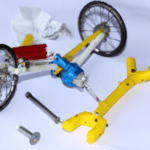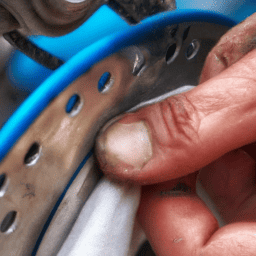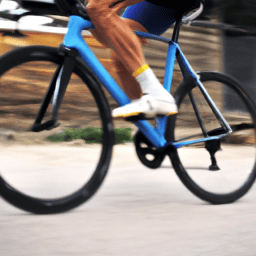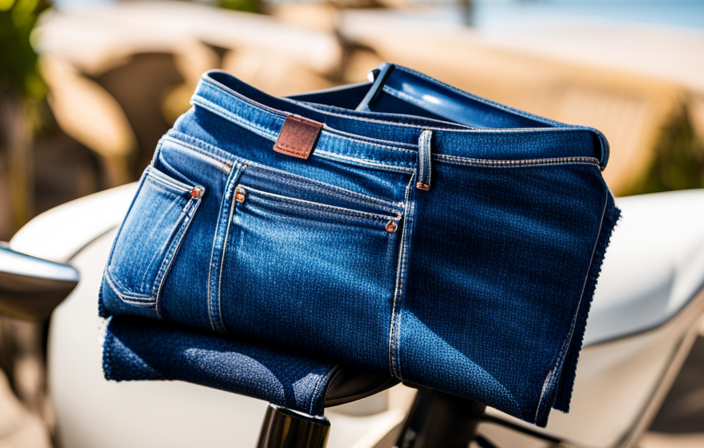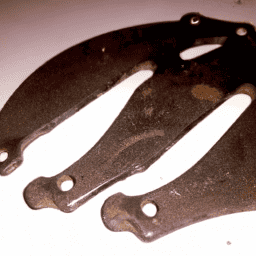Keeping your bicycle in top shape is crucial for anyone who rides. If you don’t take care of your bike, you might end up with a flat tire when you least expect it, or worse, it could cause a serious crash. That’s why I’ve come to share my knowledge on how to properly maintain your bicycle.
I’ll admit that at first, the thought of taking apart my bike and tinkering with its components was intimidating. However, once I started learning about the various parts and how they work together, I became fascinated with the mechanics of my favorite mode of transportation.
In this article, I’ll walk you through the basics of keeping your bike in tip-top shape, from cleaning and checking its components to fixing a flat tire and replacing parts. So, grab your tools and let’s get started on this journey to becoming a bike maintenance pro.
Key Takeaways
- Neglecting maintenance can lead to accidents and costly repairs, so regular maintenance is crucial.
- Proper cleaning of bike parts with appropriate products can extend the lifespan of the bike.
- Choosing the right replacement parts requires compatibility considerations and proper installation.
- Proper bike storage solutions can prevent rust, corrosion, and theft, and can extend the lifespan of the bike.
Cleaning Your Bike
Now it’s time for you to get your hands dirty and give your bike a good scrubbing to keep it looking sharp and running smoothly.
First things first, choose the right cleaning products. It’s important to use a cleaner that is specifically made for bikes, as using other household cleaners can damage the bike’s paint and components. Look for a cleaning solution that is biodegradable and eco-friendly. You can also opt for a degreaser to help remove any stubborn grime or grease on the chain and gears.
Next, let’s talk about how to clean those hard to reach areas. Use a soft-bristled brush or sponge to gently scrub the frame, wheels, and other components. For tight spots like the cassette and derailleur, use an old toothbrush or a brush specifically made for bike cleaning.
Don’t forget to rinse the bike thoroughly with water and dry it off with a clean towel or air compressor.
Checking and adjusting your bike’s components is the next step in keeping it in top condition.
Checking and Adjusting Your Bike’s Components
First things first, you’ve got to make sure your ride is running smoothly by checking and adjusting all the important components. Here are some key tasks to keep your bike in top condition:
-
Keep your bike well-lubricated to prevent rust, corrosion, and damage to moving parts. Use a good quality lubricant on the chain, derailleur, pedals, and brake levers. Apply a thin layer of lubricant and wipe off any excess to avoid attracting dirt and debris.
-
Properly functioning brakes are crucial for safe riding. Check your brake pads for wear and adjust them if they are too loose or too tight. Test your brakes by squeezing the levers and making sure they engage smoothly and quickly.
In addition to these tasks, you should also:
-
Check your bike’s gears and shifters for smooth operation.
-
Ensure your tires are properly inflated.
-
Inspect your bike for any signs of damage or wear.
By doing regular maintenance, you can avoid costly repairs and keep your bike in top condition.
Now that you’ve checked and adjusted your bike’s components, it’s time to move on to fixing a flat tire.
Fixing a Flat Tire
Alright, time to tackle the dreaded flat tire.
First, I’ll need to remove the tire from the bike.
Then, I’ll locate the puncture and fix it using a patch kit or replacing the tube entirely.
Finally, I’ll reinstall the tire and make sure it’s properly inflated before hitting the road again.
Let’s get started!
Removing the Tire
To get that tire off, you’ll need to release the brake and shift the gears to the smallest cog. This will give you enough slack in the chain to be able to remove the wheel without any issues. Make sure to have the proper tools on hand, including a tire lever, to assist with removing the tire from the wheel.
Before attempting to remove the tire, troubleshoot any issues that may arise. Check to make sure the brake is fully released and that the wheel is seated properly in the dropouts. If the tire is particularly stubborn, try using a bit of lubricant around the edge of the tire to help loosen it up.
Once the tire is off, you can move on to fixing the flat by locating the puncture and patching or replacing the tube.
Fixing the Flat
Once you’ve successfully removed the tire, it’s time to roll up your sleeves and get to work on fixing the flat. First, inspect the tire for any sharp objects that may have caused the puncture. If you find anything, remove it carefully.
Then, follow these steps:
- Locate the puncture in the tube by inflating it slightly and listening for the hissing sound or by submerging it in water and watching for bubbles.
- Use a patch kit to repair the puncture. There are different patch kit options available, but most kits include a sandpaper square, a tube of glue, and a patch.
- Roughen the area around the puncture with the sandpaper, apply a thin layer of glue, and wait for it to dry for a few minutes.
- Apply the patch firmly over the puncture and hold it in place for a few seconds.
Preventing future flats is important, especially if you frequently ride on rough terrain. One way to reduce your chances of getting a flat is to use puncture-resistant tires or tire liners. You can also make sure your tires are properly inflated and avoid riding over sharp objects.
To reinstall the tire, follow the same steps you used to remove it, but in reverse order. Make sure the tire is aligned properly with the rim and inflate it to the recommended pressure.
With a repaired or replaced tube and properly installed tire, you’ll be back on the road in no time.
Reinstalling the Tire
Now that you’ve fixed the flat, it’s time to put the tire back on. Don’t worry, it’s as easy as pie!
Before you begin, make sure the tire is properly inflated to the recommended pressure level. The recommended pressure level can be found on the sidewall of the tire. This is important because underinflated tires can cause damage to the rim and affect the handling of the bike. Proper inflation is also key for a smooth and comfortable ride.
Once you’ve ensured proper inflation, it’s time to put the tire back on. First, make sure that the tire is properly seated on the rim. Then, using your hands, work the tire back onto the rim, starting at the valve stem and working your way around the wheel. Be sure to check that the tire is properly seated on both sides of the rim.
Once the tire is back on, check the pressure one more time and adjust if necessary. Proper tire pressure monitoring is essential for a safe and efficient ride.
With the tire back on and properly inflated, you’re ready to hit the road!
To replace bike parts, you’ll need to have the right tools and some basic knowledge of bike mechanics.
Replacing Bike Parts
When it comes to replacing bike parts, there are three key points that I want to cover:
-
Identifying parts that need replacement: it’s important to know how to identify which parts need to be replaced. This can be done through regular inspections and maintenance checks.
-
Choosing the right replacement parts: choosing the right replacement parts is crucial for ensuring that your bike runs smoothly and safely. You’ll want to make sure that you select the correct size, material, and compatibility with your bike model.
-
Installing the replacement parts: installing the replacement parts requires a certain level of technical skill and attention to detail. It’s important to follow the manufacturer’s instructions carefully and use the appropriate tools to ensure a proper installation.
Identifying Parts that Need Replacement
Identifying which parts of your bike need replacement is a crucial aspect of maintaining its overall performance and longevity. Signs of wear and tear can be easily spotted during routine maintenance checks or when you experience difficulties while riding.
Common parts that need replacement include the chain, brake pads, tires, and cables. For instance, a stretched chain can cause gear slippage, while worn-out brake pads can compromise your stopping power and put you at risk of accidents.
DIY replacement is possible for some parts, but it’s important to have the right tools and know-how. For instance, replacing a chain requires a chain tool and proper sizing, while tire replacement requires tire levers and a pump. If you’re not confident in your skills, it’s best to take your bike to a professional mechanic.
Remember that replacing parts promptly not only ensures your safety but also saves you money in the long run by preventing further damage. Now that you know which parts need replacement, let’s move on to choosing the right replacement parts.
Choosing the Right Replacement Parts
To pick the perfect replacement parts, you’ll need to be as careful as a surgeon with a scalpel, selecting components that are compatible with your bike’s model and specifications. Here are some compatibility considerations to keep in mind when choosing the right replacement parts:
-
Frame compatibility: The replacement parts you choose must be compatible with your bike’s frame, which includes the size, shape, and material of the frame. For example, if you have a carbon fiber frame, you’ll need to choose replacement parts that are designed for use with carbon fiber frames.
-
Component compatibility: The replacement parts you choose must also be compatible with the components on your bike. For example, if you’re replacing a chain, you’ll need to choose a chain that is compatible with the number of gears on your bike.
-
Brand vs. generic options: When choosing replacement parts, you’ll need to decide whether to go with a brand name or generic option. Brand name parts tend to be more expensive, but they often come with a higher level of quality and reliability. Generic parts, on the other hand, are often less expensive and may work just as well as brand name parts.
When you’ve chosen the right replacement parts, the next step is to install them properly.
Installing the Replacement Parts
Now it’s time for me to get my hands dirty and start installing those replacement parts properly, so I can feel the satisfaction of a job well done. Before starting, I need to ensure that I have the proper tools for the job.
It’s important to have the right size wrenches, screwdrivers, and other tools to avoid damaging the parts or the bike itself. Using the wrong tools can also be dangerous and cause injury.
Additionally, I need to take safety precautions while working on my bike. I should wear gloves to protect my hands and eye protection to prevent any debris from getting into my eyes. It’s also a good idea to work in a well-lit and ventilated area to avoid any accidents.
By being careful and taking the necessary precautions, I can safely and effectively install the replacement parts.
With the replacement parts installed, it’s time to move on to the next step: storing my bike.
Storing Your Bike
Don’t forget to store your bike in a dry and secure location, even if you think you’ll be using it again soon – this will prevent rust and theft. Neglecting proper storage solutions can lead to costly and time-consuming repairs down the road.
Here are four effective ways to keep your bike safe and in top condition:
-
Hang it up: Using a bike rack or wall mount is a great way to keep your bike off the ground and out of the way. This also prevents it from getting knocked over or damaged by other objects.
-
Cover it: Invest in a bike cover to protect your bike from dust, dirt, and other environmental factors. This will also keep it hidden from potential thieves.
-
Use a shed or garage: Keeping your bike indoors is always the best option. If you have a shed or garage, use it to store your bike and keep it out of the elements.
-
Keep it clean: Before storing your bike, make sure to wash it thoroughly and dry it off completely. This will prevent any moisture from causing rust and corrosion.
By following these simple steps, you can ensure that your bike stays in top condition and is ready to ride whenever you are. Proper storage solutions are key to preventing rust and corrosion, and ultimately extending the lifespan of your bike.
Frequently Asked Questions
How often should I replace my bike chain?
I replace my bike chain every 2000-3000 miles to ensure optimal chain durability. Regular chain maintenance techniques such as cleaning and lubrication can extend the lifespan. Always check for wear and stretch regularly.
How do I properly adjust my bike’s brakes?
To properly adjust my bike’s brakes, I first diagnose common mistakes such as misaligned pads or cable tension issues. Troubleshooting techniques involve inspecting the brake system and making necessary adjustments. Choosing the right brake pads involves considering materials and durability for optimal performance.
Can I use dish soap to clean my bike?
Yes, dish soap can be used for bike cleaning. Pros include affordability and easy accessibility. Cons include potential damage to paint and stripping of lubricant. Alternatives include specialized bike cleaners and gentle soap solutions.
How do I know if my bike’s suspension needs servicing?
To determine if my bike’s suspension needs servicing, I check for common suspension issues like leaks, worn seals, and reduced travel. If necessary, I perform DIY suspension maintenance, including cleaning, lubrication, and replacing damaged parts.
What is the best way to lubricate my bike’s chain?
To lubricate my bike’s chain, I use a dry lubricant like Rock N Roll or Finish Line. I apply the lubricant to the chain while turning the pedals backwards and wipe off any excess. Regular chain lubrication techniques are crucial to maintaining a smooth ride.
Conclusion
Well, that’s it for my guide on bicycle maintenance. I hope that you found it helpful and that you’re feeling confident about taking care of your own bike.
Remember, regular maintenance is key to keeping your bike running smoothly and avoiding costly repairs down the line.
But even with all the knowledge and skills in the world, sometimes things can still go wrong. That’s why it’s important to always be prepared and carry the necessary tools and equipment with you on your rides.
So, with your newfound maintenance skills and a trusty toolkit, go out there and enjoy the ride with peace of mind!



